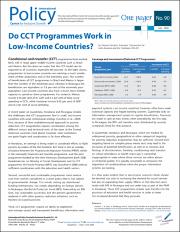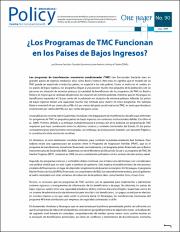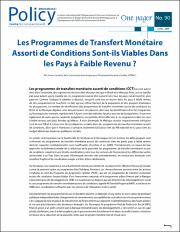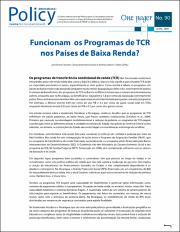Please use this identifier to cite or link to this item:
https://repositorio.ipea.gov.br/handle/11058/15257Files in This Item:
| File | Description | Size | Format | |
|---|---|---|---|---|
| en_IPCOnePager90.pdf | 58.15 kB | Adobe PDF |  View/Open | |
| es_IPCOnePager90.pdf | 189.3 kB | Adobe PDF |  View/Open | |
| fr_IPCOnePager90.pdf | 193.03 kB | Adobe PDF |  View/Open | |
| pt-br_IPCOnePager90.pdf | 189.65 kB | Adobe PDF |  View/Open |
| Title: | Do CCT Programmes Work in Low-Income Countries? |
| Other Titles: | ¿Los Programas de TMC Funcionan en los Países de Bajos Ingresos? Les Programmes de Transfert Monétaire Assorti de Conditions Sont-ils Viables Dans les Pays à Faible Revenu ? Funcionam os Programas de TCR nos Países de Baixa Renda? |
| Authors: | Cecchini, Simone |
| Abstract: | Conditional cash transfer (CCT) programmes have worked fairly well in large upper middle-income countries such as Brazil and Mexico. But this does not mean that the CCT model can be exported to all countries, especially the poorest. As the table shows, programmes in low-income countries are reaching a much smaller share of their population and of the extremely poor. The number of beneficiaries of CCT programmes in Brazil and Mexico is larger than the number of the extremely poor, whereas in Nicaragua the beneficiaries are equivalent to 7.8 per cent of the extremely poor population. Low-income countries also have a much more limited capacity to spend on these programmes. For instance, Mexico invests 0.44 per cent of its GDP and 4.3 per cent of total social spending in CCTs, while Honduras invests 0.02 per cent of GDP and 0.2 per cent of social spending. (...) Os programas de transferência condicional de renda (TCR) têm funcionado muito bem |
| metadata.dc.rights.holder: | International Policy Centre for Inclusive Growth United Nations Development Programme |
| metadata.dc.rights.license: | O texto e dados desta publicação podem ser reproduzidos desde que as fontes sejam citadas. Reproduções com fins comerciais são proibidas. |
| metadata.dc.type: | One Pager |
| Appears in Collections: | Publicações do IPC-IG |
Items in DSpace are protected by copyright, with all rights reserved, unless otherwise indicated.

